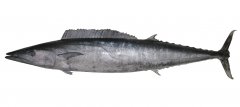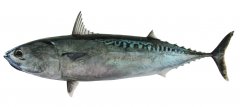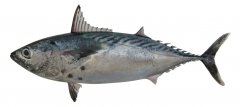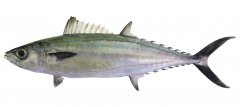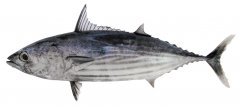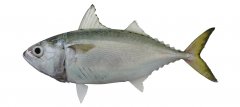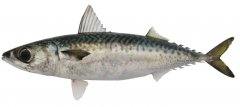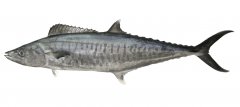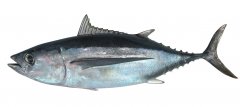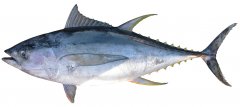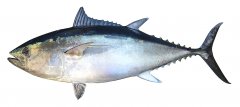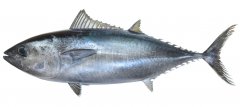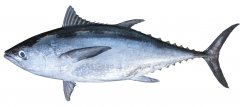All keys adapted from Collette, 2001.1
-
- 2 small keels and a large median keel between them on each side of caudal peduncle (Fig 1a); 6–10 dorsal and 6–10 anal finlets (Fig. 2); no adipose eyelids (Fig. 3a) 2
- 2 small keels, but no large median keel on each side of caudal peduncle (Fig. 1b); 5 dorsal and 5 anal finlets (Fig. 2); front and rear of eye covered with adipose eyelids (Fig. 3b) 10
-
- 2 lateral lines (Fig.4) Grammatorcynus bilineatus
- A single (upper) lateral line 3
-
- Snout as long as rest of head (Fig. 6a); gill rakers absent; first dorsal fin with 13–27 spines Acanthocybium solandri
- Snout much shorter than rest of head (Fig. 6a); at least 3 gill rakers present; first dorsal fin with 8–22 spines Scomberomorus species
-
- Dorsal fins widely separated, the space between them (the interdorsal space) more than length of first dorsal-fin base (Fig. 8a); first dorsal fin spines 10–12; interpelvic process (between pelvic-fin bases) single and large, longer than pelvic-fin rays (Fig. 9a) Auxis species
- Dorsal fins barely separated, the space between them (the interdorsal space) less than eye diameter (Fig. 8b); first dorsal fin spines 12–16; interpelvic process short and bifid, shorter than pelvic-fin rays (Fig. 9b) 7
-
- Prominent dark longitudinal stripes on belly; 53–63 gill rakers on first gill arch Katsuwonus pelamis
- No dark longitudinal stripes on belly; 19–45 gill rakers on first gill arch 8
-
- Body scaless behind corselet of enlarged and thickened scales (Fig. 10); several black spots usually present between pectoral- and pelvic-fin bases (Fig. 11) Euthynnus affinis
- Body covered with very small scales behind corselet; no black spots on body Thunnus species - FAO Thunnus
-
- 5–11 dark longitudinal stripes on upper part of body; no teeth on tongue Sarda orientalis
- Body either with or without stripes; tongue with 2 patches of teeth Gymnosarda unicolor
-
- Wavy lines on upper part of body (Fig. 12a); first anal-spine stiff and strong; teeth present on roof of mouth Scomber australasicus
- 1 or 2 horizontal rows of spots on each side of upper body (Fig. 12b); first anal-spine thin, rudimentary; no teeth on roof of mouth Rastrelliger species
-
- Posterior extension of corselet narrow, only 1–5 scales wide under origin of second dorsal fin (Fig. 1a); dorsal naked area extends anterior to pectoral-fin tips (Fig. 2a); 36–42 gill rakers on first gill arch Auxis thazard
- Posterior extension of corselet wide, 10–15 scales wide under origin of second dorsal fin (Fig. 1b); dorsal naked area does not extend to pectoral-fin tips (Fig. 2b); 43–48 gill rakers on first gill arch Auxis rochei
-
- Gill rakers not visible from side of head when mouth is open, 21–26 on lower limb of first gill arch; body moderately slender, its depth at posterior margin of opercle 4.9–6 times in fork length (Fig. 1a) Rastrelliger faughni
- Gill rakers visible from side of head when mouth is open, 30–48 on lower limb of first gill arch; body moderately deep, its depth at posterior margin of opercle 3.7–5.2 times in fork length 2
-
- Body depth at posterior margin of opercle 3.7–4.3 times in fork length (Fig. 1b) Rastrelliger brachysoma
- Body depth at posterior margin of opercle 4.3–5.2 times in fork length (Fig. 1c) Rastrelliger kanagurta
-
- Lateral line with a deep dip below second dorsal fin; body with numerous thin, wavy vertical bands Scomberomorus commerson
- Lateral line mostly straight; body with 3 irregular, horizontal rows of dark round spots Scomberomorus guttatus
-
- Gill rakers 26–34 (usually >27) on first gill arch; second dorsal and anal fins of larger individuals (120 cm fork length or longer) frequently elongate, >20% of fork length Thunnus albacares
- Gill rakers 19–27 (usually <26) on first gill arch; second dorsal and anal fins never greatly elongate, <20% of fork length at all sizes Thunnus tonggol
-
- Pectoral-fin length 20–23% of fork length; median caudal keel yellow in adults Thunnus maccoyii
- Pectoral-fin length 16–21% of fork length; median caudal keel black in adults Thunnus orientalis
-
- Caudal fin with narrow white posterior margin (Fig. 3); body narrower, streamlined and elongate with the dorsal and ventral profiles less arc shaped, being almost flat between snout and first dorsal fin (Fig. 4a) Thunnus alalunga
- Caudal fin without a white posterior margin; body deep and rounded with dorsal and ventral profile forming an arc shape from snout to caudal peduncle (Fig. 4b) Thunnus obesus
-
- White/silver body markings present as vertical lines alternating with lines of spots or elongate spots on lower sides, combined with pectoral fins extending beyond first dorsal fin 2
- White/silver body markings present as vertical lines alternating with lines of spots combined with pectoral fins not extending beyond first dorsal fin, or markings not as above, or markings absent 4
-
- White/silver body markings present as regularly spaced, vertical lines and alternating lines of spots in a ‘chevron’ pattern; markings extend anteriorly from caudal region to level of the base of the pectoral fin in fish of fresh condition (fading from upper body as condition is lost) (Fig. 1a). Dorsal-, anal-, caudal fins and finlets with strong yellow hue (fading as condition is lost). Body profile between snout and caudal peduncle streamline/fusiform compared to the more rounded arc profile of T. obesus (Fig. 2a). Head short relative to body length compared to T. obesus (Fig. 3a). Eyes smaller relative to head size and generally less elliptical in shape than for T. obesus (Fig. 4a). 26–34 gill rakers on first gill arch; no striations on ventral surface of liver, left lobe elongated (Fig. 5a); swimbladder present, usually deflated or slightly inflated, occupying only anterior portion of body cavity (Fig. 6a) Thunnus albacares
- White/silver body markings present but not in ‘chevron pattern’ (i.e. not in a combination of solid lines and lines of spots) 3
-
- White/silver body markings in irregularly spaced, complete and broken vertical lines, generally more widely spaced than in T. albacares, mostly confined to lower portion of body, extending anteriorly from caudal region usually to mid body in fish of fresh condition (fading from mid body as condition is lost) (Fig. 1b). Finlets with yellow hue and black posterior margin (turning dusky yellow/grey as condition is lost). Body shape broad at deepest point, body profile between snout and caudal peduncle forming a rounded arc compared to the less broad, torpedo-like profile of T. albacares (Fig. 2b). Head longer relative to body length compared to T. albacares (Fig. 3b). Eyes larger (relative to head size) and generally more elliptical in shape than for T. albacares (Fig. 4b). 23–31 gill rakers on first gill arch; ventral surface of liver striated, lobes roughly equal in length (Fig. 5b); swimbladder present, large and often inflated, occupying entire body cavity (Fig. 6b) Thunnus obesus
- White/silver body markings as elongated spots in horizontal rows on sides of lower body (fading as condition is lost) (Fig. 1c). Finlets yellowish with grey edges. Body shape torpedo-like, posterior portion of body (from deepest point to caudal peduncle) long relative to body length (Fig. 7). 19–27 gill rakers on first gill arch; no striations on ventral surface of liver, left lobe elongate (Fig. 5b); swimbladder absent Thunnus tonggol
-
- White/silver body markings as vertical lines and alternating lines of spots, mostly confined to lower portion of body (Fig. 1d). Finlets yellow; anal fin and second dorsal fin with yellow hues (all colouration fading as condition is lost). Body deep, broad. Thunnus orientalis
- White/silver body markings present in stressed alive and freshly dead specimens only, usually confined to the rear portion of the body as irregularly spaced, broken or complete vertical lines (Fig. 1e, alive stressed/freshly dead). White/silver markings disappear soon after death, leaving uniform silver colour (Fig. 1e, freshly dead). Anal fin and finlets dusky yellow edged with black. Body deep and broad. 31–34 gill rakers on first gill arch; ventral surface of liver striated, lobes roughly equal in length (Fig. 5d) Thunnus maccoyii
-
- White/silver body markings present in stressed alive and freshly dead specimens only as horizontal, irregularly spaced, broken and incomplete lines and blotches (Fig. 1f alive stressed/freshly dead). White/silver markings disappear soon after death, leaving uniform silver colour (Fig. 1f, dead). Dorsal and anal finlets dark in colour, caudal fin with white posterior margin (Fig. 8). Body shape narrow and fusiform. Ventral surface of liver striated, lobes roughly equal in length (Fig. 5e). Thunnus alalunga
-
- White/silver body markings present as vertical lines alternating with lines of spots or elongate spots on lower sides, combined with pectoral fins extending beyond first dorsal fin 2
- White/silver body markings present as vertical lines alternating with lines of spots combined with pectoral fins not extending beyond first dorsal fin, or markings not as above, or markings absent 4
-
- White/silver body markings in regularly spaced, vertical lines and alternating lines of spots in a ‘chevron’ pattern (Fig. 1a)/24/02/0tzhUmhpzJB7mpPn.jpg). Markings extend anteriorly from caudal region to level of the base of the pectoral fin in fish of fresh condition (fading from upper body as condition is lost). Dorsal-, anal-, and caudal fin with strong yellow hue, finlets yellow, sometimes with a narrow black posterior margin (all colouration fading as condition is lost) (Fig. 2a). Body profile between snout and caudal peduncle streamline compared to the rounded arc profile of T. obesus (Fig. 3a). Head (snout to operculum) shorter relative to total body length, than for T. obesus (Fig. 4a). Eyes smaller relative to head size and generally less elliptical in shape than for T. obesus (Fig. 5a). Pectoral fins medium length, reaching to level of second dorsal fin but not beyond (Fig. 6a); broader than that of T. obesus. Pectoral-fin tip stiff and bluntly rounded, appearing straight and blade like when viewed from above (Fig. 7a). Greatly extended second dorsal and anal fins in large specimens, reaching well over 20% of FL (Fig. 8). Central portion of trailing edge of caudal fin with 2 ridges, giving the appearance of an ‘M’ or ‘V’ shaped notch (Fig. 9a). 26–34 gill rakers on first gill arch; no striations on ventral surface of liver, right lobe elongated (Fig. 10a); swimbladder present, usually deflated or slightly inflated, occupying anterior portion of body cavity (Fig. 11a) Thunnus albacares
- White/silver body markings present but not in ‘chevron pattern’ (i.e. not in a combination of solid lines and lines of spots) 3
-
- White/silver body markings in irregularly spaced vertical lines only, generally more widely spaced than in T. albacares (Fig. 1b). Markings extend anteriorly from caudal region usually to mid body in fish of fresh condition. Dorsal-, anal-, and caudal fin dusky, sometimes with a slight yellow hue, finlets yellow with black posterior margin (colouration fading from mid body as condition is lost) (Fig. 2b). Body profile between snout and caudal peduncle forming a rounded arc compared to the less broad more streamline profile of T. albacares (Fig. 3b). Head (snout to operculum) longer, relative to total body length, than for T. albacares (Fig. 4b). Eyes larger relative to head size and generally more elliptical in shape than for T. albacares (Fig. 5b). Pectoral fins long, reaching beyond level of second dorsal fin, sometimes level with second dorsal finlet in fish greater than 50 cm FL, often curving ventrally at the tip (Fig. 6b). Pectoral-fin tips tapering to a thin, flexible point, also forming an arc shape when viewed from above (Fig. 7b). Central portion of trailing edge of caudal fin with 2 ridges giving the appearance of an ‘M’ or ‘V’ shaped notch (Fig. 9b). 23–31 gill rakers on first gill arch; ventral surface of liver striated, lobes roughly equal in length (Fig. 10b); swimbladder present, large and often inflated, occupying entire body cavity (Fig. 11b) Thunnus obesus
- White/silver body markings as elongated spots in horizontal rows on sides of lower body (fading as condition is lost) (Fig. 1c). Finlets yellowish with grey edges. Body shape torpedo-like, posterior portion of body (from deepest point to caudal peduncle) long relative to fork length (Fig. 12). Pectoral fins moderate in length but not reaching origin of second dorsal fin (Fig. 6c). 19–27 gill rakers on first gill arch; no striations on ventral surface of liver, right lobe elongated (Fig. 10c); swimbladder absent Thunnus tonggol
-
- White/silver body markings as vertical lines and alternating lines of spots, mostly confined to lower portion of body (Fig. 1d). Markings fade in large adults. Anal and second dorsal with yellow hues, finlets yellow (all colouration fading as condition is lost). Body deep, broad. Pectoral fin short, never reaching dorsal interspace (Fig. 6d) Thunnus orientalis
- White/silver markings present in stressed live and freshly dead individuals only, appearing more prominently on the rear portion of the body as vertical, irregularly spaced, often broken or incomplete lines (Fig. 1e, alive). White/silver markings disappear soon after death, leaving uniform silver colour (Fig. 1e, dead). Anal fin and finlets dusky yellow edged with black. Deep (broad) body. Short pectoral fin, never reaching interspace between the dorsal fins (Fig. 6e). 31–34 gill rakers on first gill arch; ventral surface of liver striated, lobes roughly equal in length (Fig. 10d); swimbladder present and usually deflated. Thunnus maccoyii
-
- White/silver body markings on the sides and belly of stressed alive and freshly dead specimens only, present as horizontal, irregularly spaced, broken and incomplete lines and blotches (Fig. 1f, alive stressed/freshly dead). White/silver markings disappear soon after death, leaving uniform silver colour (Fig. 1f, dead). Anal and dorsal finlets dark in colour, caudal fin with white posterior margin (Fig. 13). Body shape fusiform, its greatest depth further posterior than other tuna. Pectoral fin very long, reaching beyond origin of second dorsal, often to second dorsal finlet (Fig. 6f). 25–31 gill rakers on first gill arch; ventral surface of liver striated, lobes roughly equal in length (Fig. 10e); swimbladder present Thunnus alalunga
Carangidae
Trevallies, queenfish, scads etc.
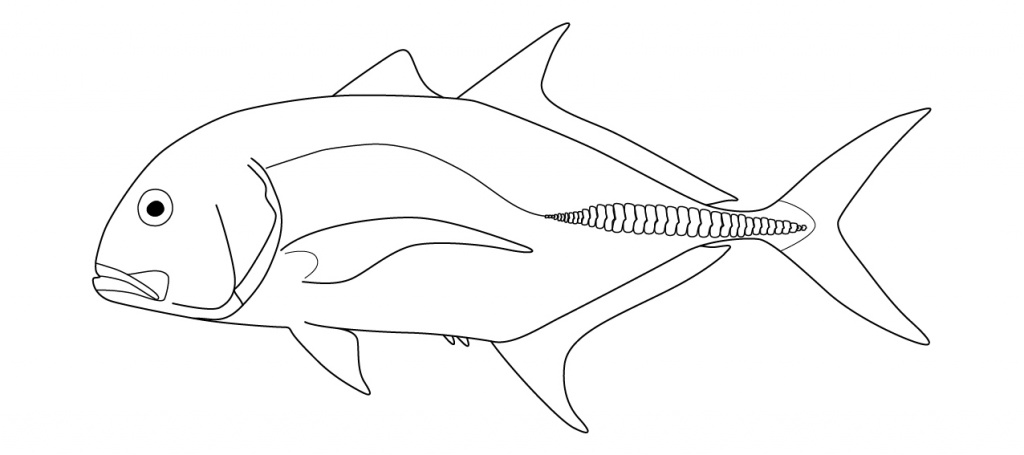
Carangidae differ in having 3 to 8 dorsal fin spines (vs. 9 to 27 in Scombridae); 2 detached spines in front of anal fin (vs. spines absent); scutes along posterior part of lateral line (vs. scutes absent) and usually no well developed finlets, except in Elagatis and Decapterus with 1 dorsal and 1 anal finlet (vs. well developed finlets).
Gempylidae
Snake mackerels
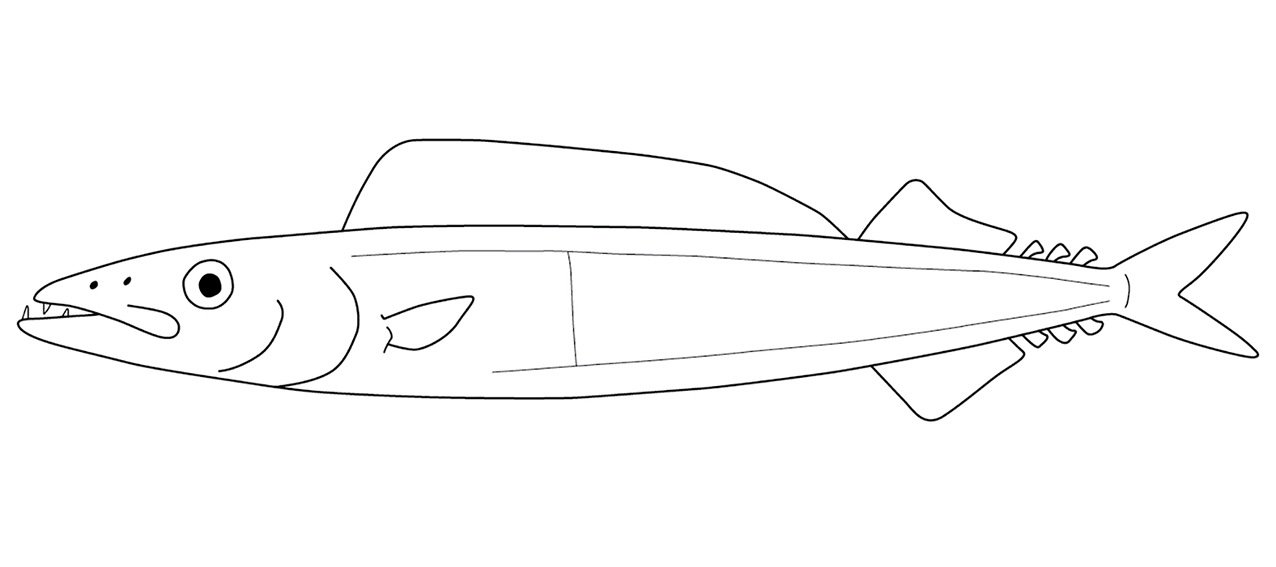
Gempylidae differ in having brown or black colouration, rarely blue-brown (vs. silver, white and blue); never with distinct markings on body (vs. markings in the form of spots, bars, lines and stripes) and no keels on caudal peduncle, except in Lepidocybium flavobrunneum (vs. keels present).
- Carpenter K, Niem V, Collette BB. Scombridae. In: FAO Species Identification Guide for Fishery Purposes. The Living Marine Resources of the Western Central Pacific. Volume 6. Bony Fishes Part 4 (Labridae to Latimeriidae), Estuarine Crocodiles, Sea Turtles, Sea Snakes and Marine Mammals. Vol 6. Rome: FAO Library; 2001:3721-3756. http://www.fao.org/3/y0770e/y0770e00.htm.
